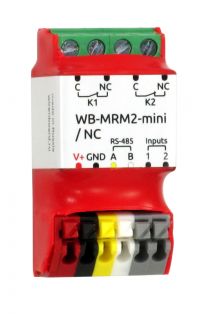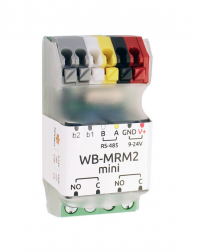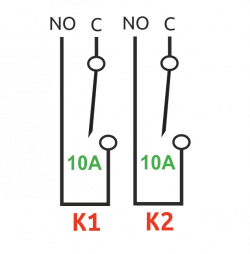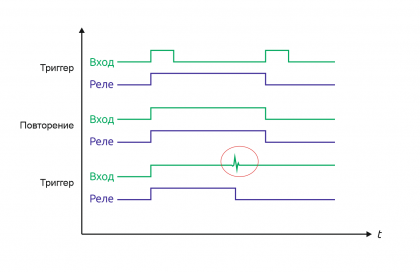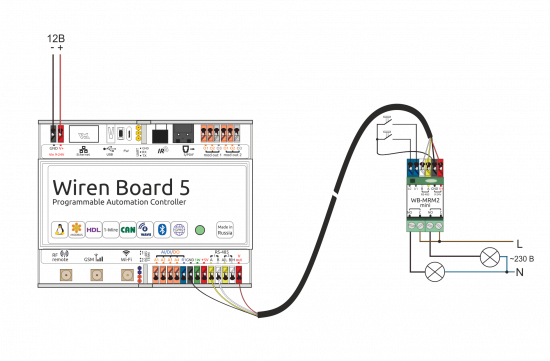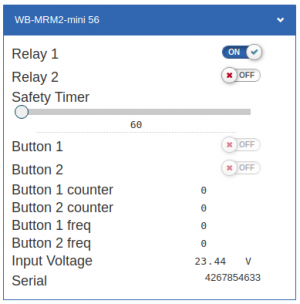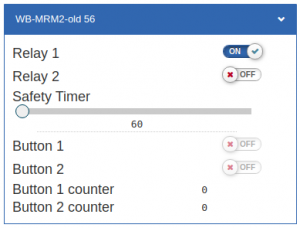Dual Channel Relay Mini-module WB-MRM2-mini
Внимание: Отображаемое название «Dual Channel Relay Mini-module WB-MRM2-mini» переопределяет ранее заданное отображаемое название «WB-MRM2-mini». Buy online
General information
Purpose
Two-channel relay module WB-MRM2-mini is designed for use in building automation systems. The module is controlled from the controller Wiren Board 6 or a computer via the bus RS-485 via Modbus Protocol, as well as via external buttons connected to the module. Miniature dimensions of the module allow you to mount it next to the load in the cable channels, bowls lamps, deep installation boxes for sockets and switches.
Outputs
The module version NO (normally open contacts) has two relays HF32F-G (Datasheet) switching the corresponding 2 outputs. Relay outputs are output to screw terminals. In case of active (resistive) load, the relays can switch up to 7 A/230 V AC and up to 7 A/30 V DC. In the case of reactive (capacitive or inductive) load (motors, switching power supplies, etc.), do not switch current more than 400 mA. Use external contactors designed for the appropriate load.
The module version of the NS (normally closed contacts) has two relays HF32F (Datasheet), switched currents are 2 times less.
Relay contacts are protected from overvoltage by TVS-diodes.
The module can enable safe mode timer, which disables all of the relay after a specified time at the termination of the data exchange through Modbus module.
Inputs
The screw-free terminals b1 and b2 of the module have 2 inputs of the dry contact type, not isolated from the power supply. RC chains are used on each input line to eliminate contact chatter. The inputs are pulled up by resistors to the +3.3 V power line. Buttons or switches with locking are connected between the GND pin and the corresponding b1 or b2 input. The inputs can be used as general-purpose inputs, for counting signals and for direct control of relay channels.
The inputs have several modes of operation: trigger mode (for control with buttons) and repeat mode (for control with switches). In the trigger mode, to change the state of the relay, it is enough to close and open the input once. The change of state occurs on the rising edge (that is, when the circuit). In the repeat mode, the relay state is determined by the input state: the input is closed — the relay is on, open — the relay is off. Details about the mode switching are written in Modbus Management Of Relay Modules.
IMPORTANT: it is not recommended to use switches (also known as lock buttons) in the trigger mode of inputs. Input interference may be perceived as a short release/push of the button and the relay status will change, although the switch will remain closed.
Technical specifications
Our detailed article in russian on habr.com about the choice of relay parameters for the switched load: https://habr.com/ru/company/wirenboard/blog/422197/
| Parameter | Value |
|---|---|
| "Power Supply" | |
| Supply voltage | 9 — 24 V DC |
| Power consumption |
|
| Terminals and wire section | |
| Recommended wire cross-section with NSUI, mm2 | 0,75 — 1 (for plates screwless terminals), 1.5 a for relay outputs |
| Length of the standard sleeve NSVE, mm | 8 (10 for adjusting screwless terminal blocks) |
| Torque of screws, N∙m | 0,2 (for screw terminals), 0,4 — for relay outputs |
| Outputs | |
| Number of outputs | 2 |
| Output type | Mechanical relay contacts |
| Contact configuration | Two-position
normally open (no version) or normally closed (NC version). |
| Output configuration | Two groups (2 outputs per group) |
| Maximum switching voltage, AC | 250 V |
| Maximum switching voltage, DC | 30 Volts |
| Maximum switching current per channel |
|
| Contact resistance | < 100 milliohms |
| Voltage isolation between the controller and the output | 1500 V (RMS value) |
| Lifetime: number of switches for load
7 A/230 V AC (resistive load) |
100 000 |
| Inputs | |
| Number of inputs | 2 |
| Input type | "Dry contact", not isolated from power supply |
| Functions |
|
| Control | |
| Management interface | RS-485 |
| Interface isolation | Uninsulated |
| Communication protocol | Modbus RTU, address is set by software, factory settings are indicated on the label |
| RS-485 interface parameters | set programmatically (see register card); default: speed — 9600 bit/s; data — 8 bit; parity bit — none (N); stop bits — 2 |
| Ready for operation after power supply | ~0.1 c |
| dimensions | |
| Overall dimensions (l x W x h) | 46 x 24 x 20.5 mm |
| Display | |
| Power and data exchange indication | In older versions up to 2018g - Green status led under shrink tube
After 2018g - is missing. |
| Relay channel status indication | no |
| operating Conditions | |
| Air temperature | |
| Relative humidity | Up to 92%, no condensation |
Module dimensions
Data exchange
At the physical level, the module is connected via RS-485 interface. Modbus RTU Protocol is used to control the meter. In Wirenboard Devices, Modbus data is transmitted over RS-485 communication lines. See the Modbus Protocol page for details. Modbus-the address of the counter is set at the factory and marked on the label. The address can be changed programmatically. Details refer to the Modbus parameters.
Installation
The relay module is freely mounted in mounting boxes, cable channels, etc.
The screw-free terminal blocks on the relay Board are used to connect power lines, control (RS-485) and input contacts. When used in the installation of tips, it is necessary that the diameter of the insulated cuffs does not exceed 3.6 mm, the wire section — 0.75 mm2, and the length of the conductive sleeve — 5-6 mm. Screw clamps accept wire section 2.5—4 mm2. The wire section must correspond to the switched load.
When connecting switched devices, it is important to remember that each of the screw terminals can withstand a current of up to 7 A.
Fixed buttons or switches are connected between the GND pins and the corresponding inputs b1 and b2. The current flowing when the button or switch is closed is small, so the type of button or switch can be any. Despite the built-in protection against rattle, choose quality buttons and switches to avoid false alarms due to bad contacts.
If the device is the last one on the RS-485 line, a 120 Ohm resistor-terminator must be installed between its inputs A and B. Practice shows that in the case of bench tests with a small length of the RS-485 line and a small number of terminator devices on the last device in the line can not be installed.
The module must be installed in such a way as to meet the requirements of electrical safety and to prevent accidental contact of contacts under high voltage. The module must be operated under recommended environmental conditions.
Add module to the web interface of the Wiren Board controller
The new device is added to the web interface in the section of the corresponding RS-485 port. In the web-interface on the right panel select Configs -> Serial Device Driver Configuration. In the /dev/ttyAPP1 port settings, add a new device (WB-MRM2 or WB-MRMR2-old, see below) by clicking on the '+ Serial device' button in the List of Devices section. Then specify the address of the device and select its type. Details about the device configuration in the web interface Wiren Board see RS-485:Настройка_через_веб-интерфейс/en.
A new device appeared in the Devices section, the name is made up of the device type and address: WB-MRM2 43
Note: the green Status led on the back of the WB-MRM2 module has started to flash intermittently, which means that the Wiren Board is communicating with the module.
The WB-MRM2 device is standard, so its description is specified in the template that is stored on the Wiren Board controller in the file /usr/share/wb-mqtt-serial/templates/config-wb-mrm2.json. In modules with firmware version up to 1.5.4 inclusive, another register card was used, where the state of the inputs was described by the discrete registers 0 and 1, in newer devices the holding registers 7 and 8 are supposed to be used. If you are using an older device, use the /usr/share/wb-mqtt-serial/templates/config-wb-mrm2-old.json. template to work correctly.
Module Control via the Wiren Board web interface
Пример управления релейным модулем WB-MRM2-mini контроллером Wiren Board 5 и программирования сценариев управления мы рассмотрим на простом макете, когда релейный модуль является единственным устройством, подключенным к контроллеру (см. схему в разделе Монтаж). Нормально разомкнутая кнопка без фиксации подключена ко входу 1 и GND. Питание 12 В подается на входы V+(+) и GND (-). Входы/выходы RS-485 A и B первого порта контроллера и модуля WB-MRM2-mini соединены.
С помощью виртуальных выключателей в web-интерфейсе Relay 1 и Relay 2 можно управлять соответствующими выходами модуля и следить за их состоянием. Если реле будет включено или выключено через внешний вход, это отразится и в web-интерфейсе.
Текущее состояние входов показывают флажки Button 1 и Button 2 (на них нельзя щелкнуть, чтобы изменить состояние). Счетчики нажатий/включений отображаются в полях Button 1 counter и Button 2 counter. Значения счетчиков хранятся в оперативной памяти микроконтроллера модуля реле и обнуляются при выключении/включении питания и сбросе.
Ползунок Safety Timer позволяет задать время отключения (в секундах) всех выходов при отсутствии обмена данными с Wiren Board (0 – таймер безопасности отключен). При возобновлении связи с контроллером выключившиеся реле останутся выключенными. Ползунком удобно управлять с помощью клавиш со стрелками, предварительно сфокусировавшись на нем мышью: перемещение ползунка с помощью мыши не обеспечивает достаточную точность. Таймер безопасности позволяет остановить технологические процессы в случае, если контроль над модулем утрачен (например, перебит кабель RS-485). Всегда учитывайте возможность потери связи с контроллером при проектировании систем управления.
Управление по Modbus
Подробно о работе с модулем по протоколу Modbus написано в разделе Управление модулями реле Wirenboard по протоколу Modbus.
Обновление прошивки устройства
Начиная с новых версий микропрограмм устройства поддерживается функционал обновления прошивки (микропрограммы) по протоколу Modbus. Это дает возможность расширять функциональные возможности устройств и устранять ошибки в микропрограммном обеспечении непосредственно на месте монтажа. Подробнее о перепрошивке устройств рассказано в статье Загрузка прошивок на устройства Wiren Board. Список версий прошивок, поддерживающих обновление, а также устройств, для которых эта функция реализована, можно найти в статье Firmware_Changelog.
Известные неисправности
Список известных неисправностей
Изображения и чертежи устройства
По ссылкам ниже вы можете скачать изображения и чертежи устройства WB_MRM2-mini_NO.
Corel Draw 2018: WB_MRM2-mini_NO.cdr.zip
Corel Draw PDF: WB_MRM2-mini_NO.cdr.pdf
Autocad 2013 DXF: WB_MRM2-mini_NO.dxf.zip
Autocad PDF: WB_MRM2-mini_NO.pdf
По ссылкам ниже вы можете скачать изображения и чертежи устройства WB_MRM2-mini_NC.
Corel Draw 2018: WB_MRM2-mini_NC.cdr.zip
Corel Draw PDF: WB_MRM2-mini_NC.cdr.pdf
Autocad 2013 DXF: WB_MRM2-mini_NC.dxf.zip
Autocad PDF: WB_MRM2-mini_NC.pdf
